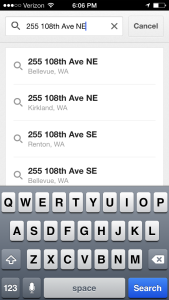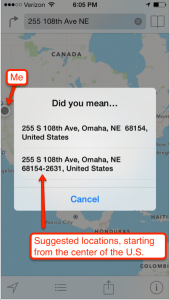iOS 7 is a great improvement over iOS 6, but we are sorely disappointed that a very simple bug fix to the iOS Maps App and the Calendar App remains undone!
Here’s the problem: if you create a calendar entry and add an address in the “Location” field, for some bizarre reason the Calendar App does not recognize the full address.
Here’s an example: a meeting between Rame and Arun is scheduled to take place at 255 108th Ave NE in Bellevue, Washington (which, by the way, is a well-known local office building known as the Civica Center). When you create the calendar entry, you can type in the full address like this:

But when you are viewing the calendar entry, the Calendar App only recognizes “255 108th Ave NE” as a clickable link: everything after the comma, in this case “, Bellevue” has been ignored.

That’s bug #1: a simple bug, which could be solved simply by adding some logic to read the rest of the text string after the comma since the entire field is a “location” anyway!
Now we come to the iOS bug, which is far more irritating — and, indeed, baffling considering that the Maps App was designed specifically for mobile devices with built-in GPS capabilities!
If you click on the “255 108th Ave NE” link within the Calendar App, e.g. to get driving instructions for getting to this location, the Maps App completely ignores your current location!
Instead, it starts, very bizarrely, with the center of the continental United States and offers suggestions in Omaha, Nebraska (about 1,000 miles away from the current location of the phone, as you can see from the blue dot in the upper-left corner):
Why would a Maps App designed specially for a mobile phone ignore the value of the user’s current location, and start off by suggesting locations that are hundreds of miles away?
Google Maps, in contrast, doesn’t have this problem. If you copy-and-paste just the “255 108th Ave NE” string into the Google Maps app, it wisely starts off by suggesting the closest locations, not the ones that happen to be closest to the center of the continental United States:

A problem that seems so simple to fix, and yet it persists one year after Apple’s Maps was introduced…
